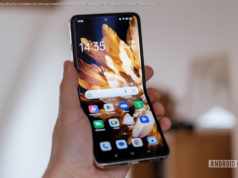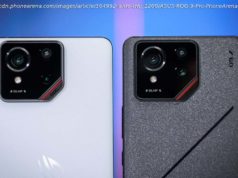Looking for a new smartphone? There are dozens upon dozens of great options on the market today, but finding the best of the best can be a bit difficult. We’ve seen some great launches through the…
Looking for a new smartphone? There are dozens upon dozens of great options on the market today, but finding the best of the best can be a bit difficult. We’ve seen some great launches through the year and more should be coming soon too, so let’s take a look at the best Android smartphones you can buy as of November 2017.
After much speculation, Razer finally announced its first foray into the smartphone industry in November with the aptly named Razer Phone. This spec-heavy “phone for gamers” actually has a lot of promise, even if it’s not going to be the first choice for everyone.
The Razer Phone doesn’t pull its punches at all with the spec sheet on this device, and that starts with the display. You’ve got a 5.7-inch QHD IGZO panel here, but what’s impressive is the 120Hz refresh rate. That not only helps makes compatible games a smoother experience, but makes the entire phone buttery smooth.
Further, the Razer Phone has a Snapdragon 835 under the hood, 8GB of RAM, 64GB of UFS storage (with microSD, of course) and a massive 4,000 mAh battery to keep the phone going all day. Razer has also included THX-certified speakers on the front of the phone, but there’s no headphone jack here, just an included 24-bit adapter.
Razer also has Android 8.1 Nougat on this device with a promised upgrade to Oreo, a dual-camera system on the back with a 12MP f/1.7 primary sensor, and interesting added features such as Nova Launcher Prime pre-installed.
You’ll be able to get the Razer Phone starting on November 15th for $699 in the US unlocked online and in select stores such as Microsoft stores, as well as in the UK from Three. You can reserve your phone from Razer’s website now.
Andy Rubin’s startup Essential saw some big issues leading up to its launch, but there’s no denying this isn’t a fantastic phone. The Essential PH-1 uses premium, durable materials to create a bezel-less slab of pure Android goodness. Under the hood, it’s running on a Snapdragon 835,4GB of RAM, and 128GB of storage, all leading to pretty impressive performance with the stock Android build.
The Essential Phone doesn’t offer much in terms of features, but it does make an attempt in the camera game. There’s no hopping around the fact that the dual 12MP camera around back is disappointing, but things are continually getting better and the company’s 4K 360-degree camera mod is a pretty impressive addition to the phone.
What makes this phone an awesome deal (and worthy of being placed back in our “new” section for this month), is the recent price cut. Essential slashed the price of this phone to just $499. For what you’re getting, that’s an insanely good deal.
Now, I know what you’re thinking. What is the several-month-old LG G6 doing at the top of this list in November? The simple answer, Amazon. LG has recently partnered up with Amazon to bring a few of its Android devices into the Prime Exclusive program, and the LG G6 is the highlight there.
You’ll still be getting the same solid 13MP dual-camera setup on the back, water resistant glass and metal body, 18:9 FullVision display, and the Snapdragon 821/4GB of RAM flagship specs, all for a discounted rate. It’s a really solid deal, as long as you can put up with the ads.
Samsung’s follow-up to the disastrous Note 7 brings back a lot of features from that popular phone, as well as introducing a new design and the biggest display ever on a Note device.
The Galaxy Note 8 brings, as you’d expect, a ton of specs and features to the table. Up front you’ve got a 6.3-inch AMOLED display at 2960×1440 which is actually the brightest display ever on a smartphone, according to DisplayMate. Around back there’s also Samsung’s new dual-camera system with its optical zoom and portrait mode effects, as well as a fingerprint sensor and heart rate sensor.
Under the hood, we’re looking at a Snapdragon 835 chipset, 6GB of RAM, 64GB of storage, and Android Nougat out of the box. That also includes Samsung’s software skin which doesn’t really change all that much from the Galaxy S8. The notable difference here is the S-Pen.
Samsung’s infamous stylus returns in the Note 8 and it packs a few new features. It’s water-resistant just like the phone and features the same levels of sensitivity found with the Note 7, and it also adds some new software features. Screen-off memos now support up to 100 pages, and Samsung has also added “Live Messages” which lets you create fun GIFs with the S-Pen for your friends.
As you’d expect, the Note 8 is a killer device going into the fall and it’s likely a smartphone no one will regret buying. However, it comes at a cost. The Note 8 is easily one of the most expensive phones on the market today at $930 and up, but if you’re interested despite that, pre-orders are available now.
The original Google Pixel was one of our favorite phones of last year, and this year, Google is stepping up its game in a big way. The Pixel 2 family differs from last year by introducing some pretty stark differences between the two phones, so let’s talk about them.
First, let’s discuss what these two devices share in common, and that’s their specifications. Both Pixel 2 devices pack a Snapdragon 835 processor, 4GB of RAM, 64 or 128GB of storage without a microSD slot, and USB-C for charging and audio (sadly, there are no headphone jacks here). Along with that, there’s IP67 dust and water resistance, front-facing stereo speakers on both units, and Android 8.0 Oreo with a brand new launcher.
Both devices also share the same spectacular cameras. According to Google, the new 12MP f/1.8 sensor is significantly better compared to last year’s sensor, and early results are brilliant. That’s partially thanks to the addition of OIS, and Google’s software skills are improved this year, leading to a portrait mode that works with just one camera on both the rear and front cameras.
Now, for the differences. On the Pixel 2, we’re looking at a 5-inch, OLED display with pretty significant bezels up top and at the bottom. The smaller Pixel is also available in three colors — Just Black, Clearly White, and Kinda Blue. As for the Pixel 2 XL, there’s a 6-inch 18:9 P-OLED display with slimmed down (but not totally gone) bezels all around. This one is available in two colors — Black and Black & White (aka Panda or Stormtrooper).
As far as pricing goes, the Pixel 2 starts at $649 for the 64GB model and $749 for the 128GB model. The Pixel 2 XL starts at $849 for the 64GB model and goes up to $949 for 128GB. Monthly financing is available on both phones and you can also use Google’s new trade-in program to put a few extra dollars towards it. Verizon Wireless is once again the exclusive carrier of the Pixel 2 and has orders open now as well.
Another excellent option launching this fall is the LG V30. While it might not get as much attention as the Note, LG has a serious winner on its hands here. The V30 is powered by the Snapdragon 835 processor, 4GB of RAM, and 64GB of storage with Nougat on board and LG’s skin. Not much has changed with the software outside of the addition of a “floating bar” for shortcuts, but with these specs under the hood, this phone runs well.
The V30 also packs LG’s first mainstream OLED display and it’s excellent. The 6-inch panel is sharp, has vibrant colors, and is very bright as well. The bezel-less design keeps the phone compact in the hand as well.
One of LG’s most notable features on the V30, though, is the dual-camera system around back. While the company’s standard and super wide-angle sensors are nothing particularly new, the record-setting f/1.6 aperture on the standard 16MP sensor and f/1.9 aperture on the wide-angle 13MP sensor nearly perfect the formula.
Nearly a month after its initial announcement, the V30 is finally up for sale here in the United States. Pricing varies by carrier but lands between $27-$38 a month between the major 4. A more specific breakdown is available here.
HTC hasn’t seen too much success in the past two years, but the company’s latest flagship, the HTC U11, looks like a winner as far as I’m concerned. The U11 offers up a design similar to that of the HTC U Ultra with a “liquid” glass finish and top of the line specifications. HTC has included the new “Edge Sense” pressure sensitivity tech for quick launching apps and shortcuts, and the device also features the latest version of Android Nougat out of the box.
Under the hood, the HTC U11 offers up the Snapdragon 835 processor, 4GB of RAM, 64GB of storage, and a 3,000 mAh battery. There’s no 3.5mm headphone jack, but the device does offer USB-C headphones in the box as well as an adapter for using traditional headphones.






